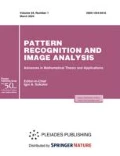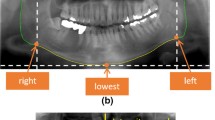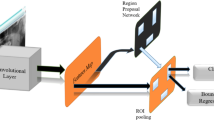Abstract
Deep Convolution Neural Network is one of the most powerful tools to solve complex problems of image classification, image recognition, financial analysis, medical diagnosis and many similar problems. A dental panoramic image consists of collection of teeth of both upper jaw and lower jaw. Automatic classification of dental panoramic images into various tooth types such as canines, incisors, premolars and molars has been a challenging task and involves crucial role of an experienced dentist. In this paper, we propose a technique for numbering and classification of the panoramic dental images. The proposed algorithm consists of four stages namely pre-processing, segmentation, numbering and classification. The pre-processed panoramic dental images are segmented using fuzzy c-mean clustering and subjected to vertical integral projection to extract a single tooth. The image dataset consists of 400 dental panoramic images collected from various dental clinics. The 400 dental images are divided into 240 training samples and 160 testing samples. The image data set is augmented by applying various transformations. Panoramic dental images are further numbered using a universal dental numbering system. Finally, the classification is done with the help of 6-layer deep convolution neural network (DCNN) consisting of 3 convolutional neural network and 3 fully connected network. The tooth is classified as canine, incisor, molar and premolar. An accuracy of 95% has been achieved for augmented database and 92% for original dataset with the proposed algorithm. The proposed numbering and classification of dental panoramic images is useful in biomedical application and postmortem recording of dental records. In case of big calamity, the system can also assist the dentist in recording post mortem dental record that is a very lengthy and arduous task.










Similar content being viewed by others
REFERENCES
J. L. Fuller, G. E. Denehy, and T. M. Schulein, Concise Dental Anatomy and Morphology, 4th ed. (University of Iowa, Iowa City, 2001). ISBN 978-0874141252
F. Pongrácz and Z. Bárdosi, “Dentition planning with image-based occlusion analysis,” Int. J. Comput. Assist. Radiol. Surg. 1 (3), 149–156 (2006).
M. L. Tangel, C. Fatichah, F. Van, J. P. Betancourt, M. R. Widyanto, F. Dong, and K. Hirota, “Dental numbering for periapical radiograph based on multiple fuzzy attribute approach,” J. Adv. Comput. Intell. Intell. Inf. 18 (3), 253–261 (2014).
M. Hosntalab, R. Aghaeizadeh Zoroofi, A. Abbaspour Tehrani-Fard, and G. Shirani, “Classification and numbering of teeth in multi-slice CT images using wavelet-Fourier descriptor,” Int. J. Comput. Assist. Radiol. Surg. 5 (3), 237–249 (2010).
J. Zhou and M. Abdel-Mottaleb, “A content-based system for human identification based on bitewing dental X-ray images,” Pattern Recogn. 38 (11), 2132–2142 (2005).
P. L. Lin, Y. H. Lai, and P. W. Huang, “An effective classification and numbering system for dental bitewing radiographs using teeth region and contour information,” Pattern Recogn. 43 (4), 1380–1392 (2010).
R. B. Ali, R. Ejbali, and M. Zaied, “Detection and classification of dental caries in X-ray images using Deep Neural Networks,” in ICSEA 2016: The Eleventh International Conference on Software Engineering Advances (Rome, Italy, 2016), pp. 223–227. ISSN-978-1-61208-498-5
J. Punwutikorn, A. Waikakul, and V. Pairuchvej, “Clinically significant oroantral communications — A study of incidence and site,” Int. J. Oral Maxillofac. Surg. 23 (1), 19–21 (1994).
A. Zakirov, M. Ezhov, M. Gusarev, V. Alexandrovsky, and E. Shumilov, “End-to-end dental pathology detection in 3D cone-beam computed tomography images,” in Proc. 1st Conference on Medical Imaging with Deep Learning (MIDL 2018) (Amsterdam, The Netherlands, 2018), pp. 1–9.
A. S. Lundervold and A. Lundervold, “An overview of deep learning in medical imaging focusing on MRI,” Z. Med. Phys. 29 (2), 2019, pp. 102–127.
A. V. N. Reddy and Ch. P. Krishna, “A survey on applications and performance of deep convolution neural network architecture for image segmentation,” Int. J. Pure Appl. Math. 118 (19), 43–60 (2018).
M. D. Zeiler and R. Fergus, “Visualizing and understanding convolutional networks,” in Computer Vision—ECCV 2014, Proc. 13th European Conference, Part I, Ed. by D. Fleet, T. Pajdla, B. Schiele, and T. Tuytelaars, Lecture Notes in Computer Science (Springer, Cham, 2014), Vol. 8689, pp. 818–833.
P. Sermanet, D. Eigen, X. Zhang, M. Mathieu, R. Fergus, and Y. LeCun, “OverFeat: Integrated recognition, localization, and detection using Convolutional Networks,” in Proc. Int. Conf. on Learning Representations (ICLR 2014) (Banff, Canada, 2014), pp. 1–16; arXiv preprint arXiv:1312.6229. Available at https://arxiv.org/abs/1312.6229.
R. Girshick, J. Donahue, T. Darrell, and J. Malik, “Rich feature hierarchies for accurate object detection and semantic segmentation,” in Proc. 2014 IEEE Conf. on Computer Vision and Pattern Recognition (CVPR 2014) (Columbus, OH, USA, 2014), pp. 580–587.
S. Ren, K. He, R. Girshick, and J. Sun, “Faster R-CNN: Towards real-time object detection with Region Proposal Networks,” IEEE Trans. Pattern Anal. Mach. Intell. 39 (6), 1137–1149 (2017).
H. Agarwal, Deep Learning Methods for Visual Fault Diagnostics of Dental X-ray Systems, Thesis for the degree of Master of Science in Technology (Aalto University, School of Science, Otaniemi, 2018), pp. 1–64.
J. Zhou and M. Abdel-Mottaleb, “A content-based system for human identification based on bitewing dental X-ray images,” Pattern Recogn. 38 (11), 2132–2142 (2005).
A. Krizhevsky, I. Sutskever, and G. E. Hinton, “ImageNet classification with deep convolutional neural network,” in Advances in Neural Information Processing Systems 25: Proc. 26th Annual Conf. NIPS 2012 (Lake Tahoe, NV, USA, 2012), Vol. 1, pp. 1097–1105.
P. M. Macho, N. Kurz, A. Ulges, R. Brylka, T. Gietzen, and U. Schwanecke, “Segmenting teeth from volumetric CT data with a hierarchical CNN-based approach,” in Proc. Conf. on Computer Graphics & Visual Computing (CGVC 2018) (Swansea, UK, 2018), pp. 109–113.
S. Madhukumar and N. Santhiyakumari, “Evaluation of k-means and fuzzy c-means segmentation on MR images of brain,” Egypt. J. Radiol. Nucl. Med. 46 (2), 475–479 (2015).
Y. Miki, C. Muramatsu, T. Hayashi, X. Zhou, T. Hara, A. Katsumata, and H. Fujita, “Classification of teeth in cone-beam CT using deep convolutional neural network,” Comput. Biol. Med. 80, 24–29 (2017).
H.-C. Shin, H. R. Roth, M. Gao, L. Lu, Z. Xu, I. Nogues, et al., “Deep convolutional neural networks for computer aided detection: CNN architectures, dataset characteristics and transfer learning,” IEEE Trans. Med. Imaging 35 (5), 1285–1298 (2016).
Z. Jiao, X. Gao, Y. Wang, and J. Li, “A deep feature-based framework for breast masses classification,” Neurocomput. 197, 221–231 (2016).
G. Carneiro, J. Nascimento, and A. P. Bradley, “Automated analysis of unregistered multiview mammograms with deep learning,” IEEE Trans. Med. Imaging 36 (11), 2355–2365 (2017).
T. Kooi, G. Litjens, B. van Ginneken, A. Gubern-Mérida, C. I. Sánchez, R. Mann, A. den Heeten, and N. Karssemeijer, “Large scale deep learning for computer aided detection of mammographic lesions,” Med. Image Anal. 35, 303–312 (2017).
S. Peck and L. Peck, “A time for change of tooth numbering system,” J. Dent. Educ. 57, 643–647 (1993).
“Designation for teeth,” in Dental Abbreviation, Symbols and Acronyms, 2nd ed. (Council on Dental Practice, American Dental Association, 2008), p. 35.
M. F. Aydogdu, V. Celik, and M. F. Demirci, “Comparison of three different CNN architectures for age classification,” in Proc. IEEE 11th Int. Conf. on Semantic Computing (ICSC2017): 1st International Workshop on Semantics for Engineering and Robotics (IWSER 2017) (San Diego, CA, USA, 2017), pp. 372–377.
Y.-F. Kuo, S.-Y. Lin, C. H. Wu, S.-L. Chen, T.-L. Lin, H.-H. Lin, C.-H. Mai, and J. F. Villaverde, “A Convolutional Neural Network approach for Dental Panoramic Radiographs classification,” J. Med. Imaging Health Inf. 7 (8), 1693–1704 (2017).
W. Poedjiastoeti and S. Suebnukarn, “Application of Convolutional Neural Network in the diagnosis of jaw tumors,” Healthc. Inf. Res. 24 (3), 236–241 (2018).
Y.-J. Yu, “Machine learning for dental image analysis,” arXiv preprint arXiv:1611.09958 (2016). https://arxiv.org/abs/1611.09958.
L. Perez and J. Wang, “The effectiveness of data augmentation in image classification using deep learning,” arXiv preprint arXiv:1712.04621 (2017). https://arxiv.org/abs/1712.04621.
J.-H. Lee, D.-H. Kim, S. -N. Jeong, and S.-H. Choi, “Detection and diagnosis of dental caries using a deep learning-based convolutional neural network algorithm,” J. Dent. 77, 106–111 (2018).
Author information
Authors and Affiliations
Corresponding authors
Ethics declarations
The authors declare that they have no conflict of interest. This article does not contain any studies involving animals or human participants performed by any of the authors.
Additional information

Prerna Singh. Born 1983. Graduated from Maharishi Dayanand University in Computer Science and Engineering in 2005. Post Graduate in M. S. (Software System) from Bits, Pilani in 2012. Ph. D. Research Scholar at Department of Computer Science, University of Delhi. Author of 6 scientific research paper. Scientific interest in data analysis, data mining, image mining, pattern recognition, and classification.

Priti Sehgal. Graduated in B.Sc. (General) in Computer Science from Miranda House, University of Delhi in 1992. Post graduate in M.Sc. in Computer Science in 1994 from DAVV, Indore. PhD in computer science in 2006 from University of Delhi. Currently working as Associate Professor in Keshav Mahavidyalaya, University of Delhi. Experience of over 23 years in teaching UG and PG in University of Delhi. Published more than 40 research papers in reputed journals and conferences. Scientific interest in image processing, fuzzy logic, biometric, image retrieval, and image mining.
Rights and permissions
About this article
Cite this article
Singh, P., Sehgal, P. Numbering and Classification of Panoramic Dental Images Using 6-Layer Convolutional Neural Network. Pattern Recognit. Image Anal. 30, 125–133 (2020). https://doi.org/10.1134/S1054661820010149
Received:
Revised:
Accepted:
Published:
Issue Date:
DOI: https://doi.org/10.1134/S1054661820010149




